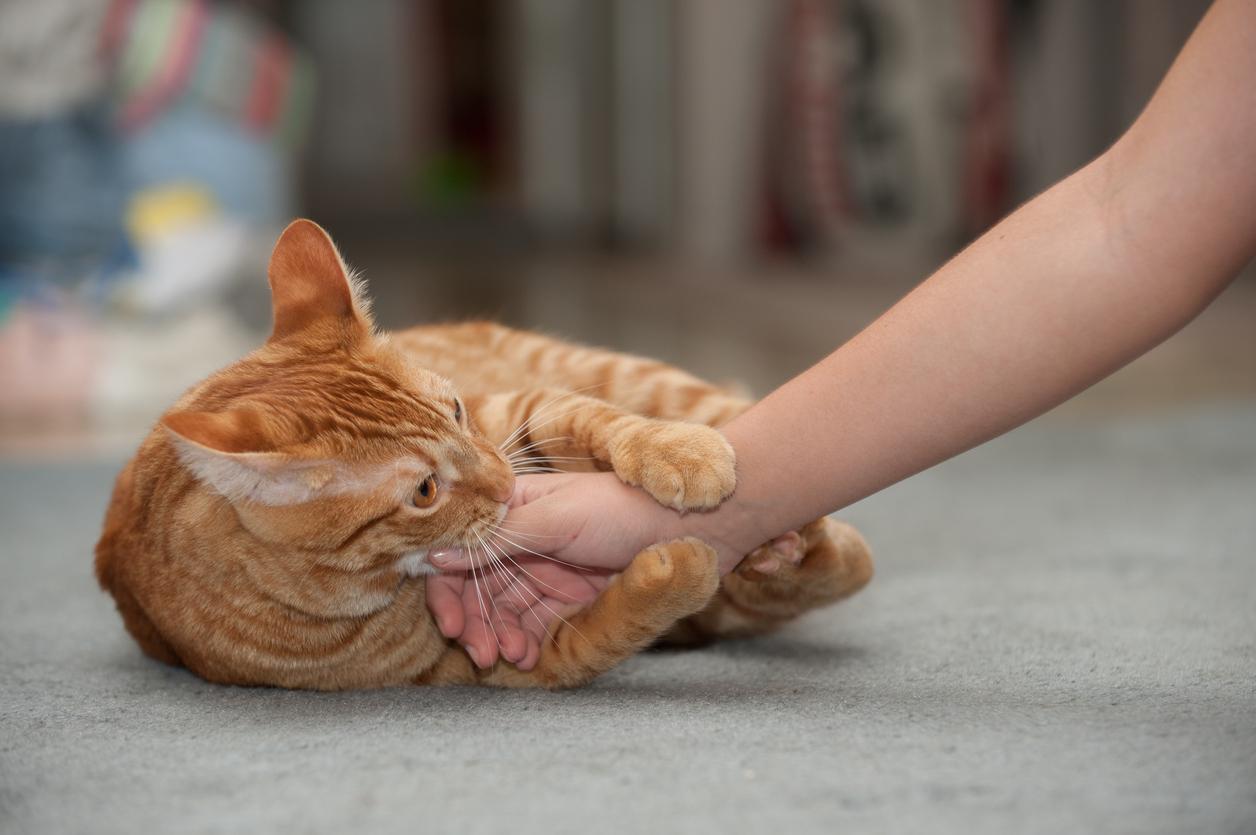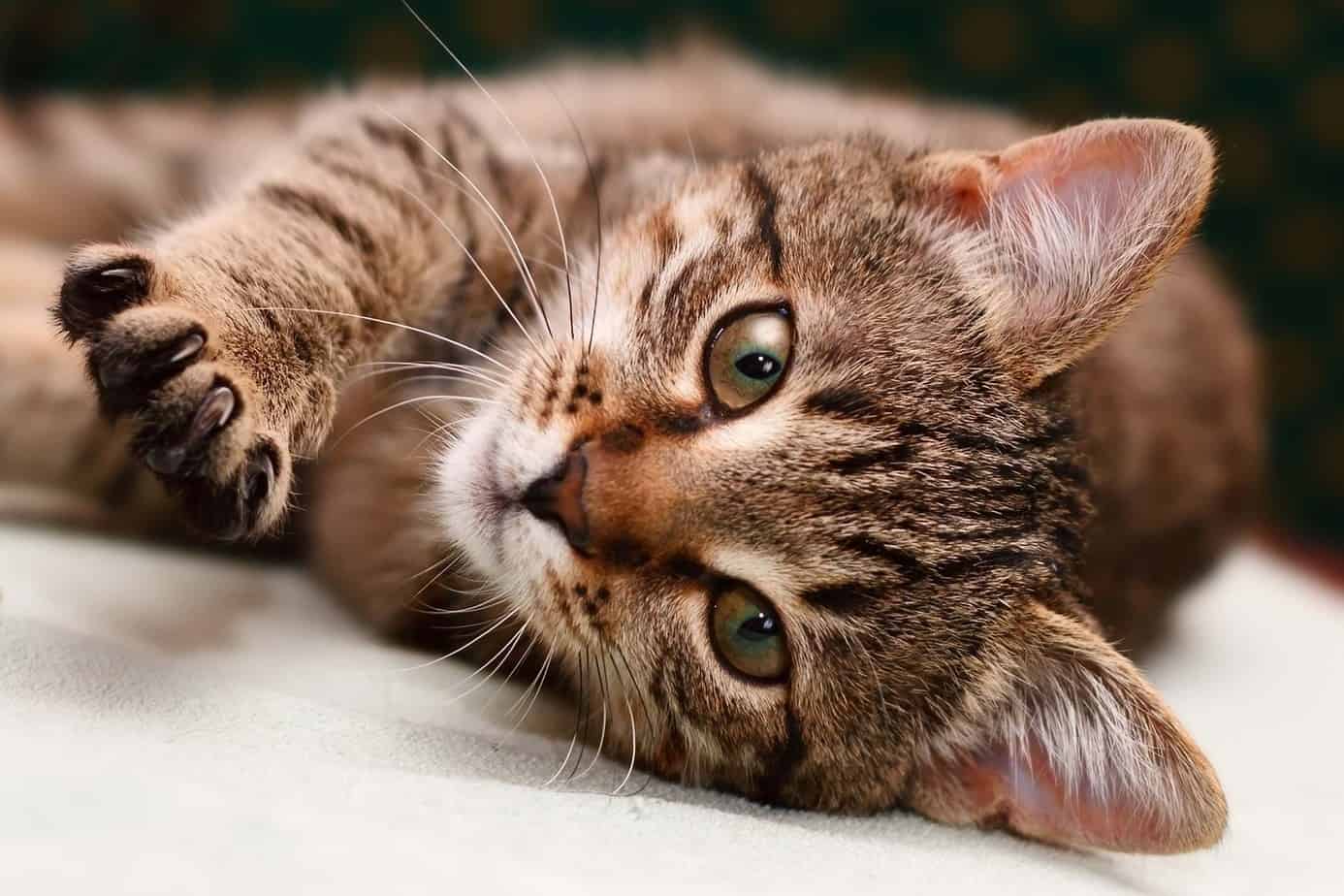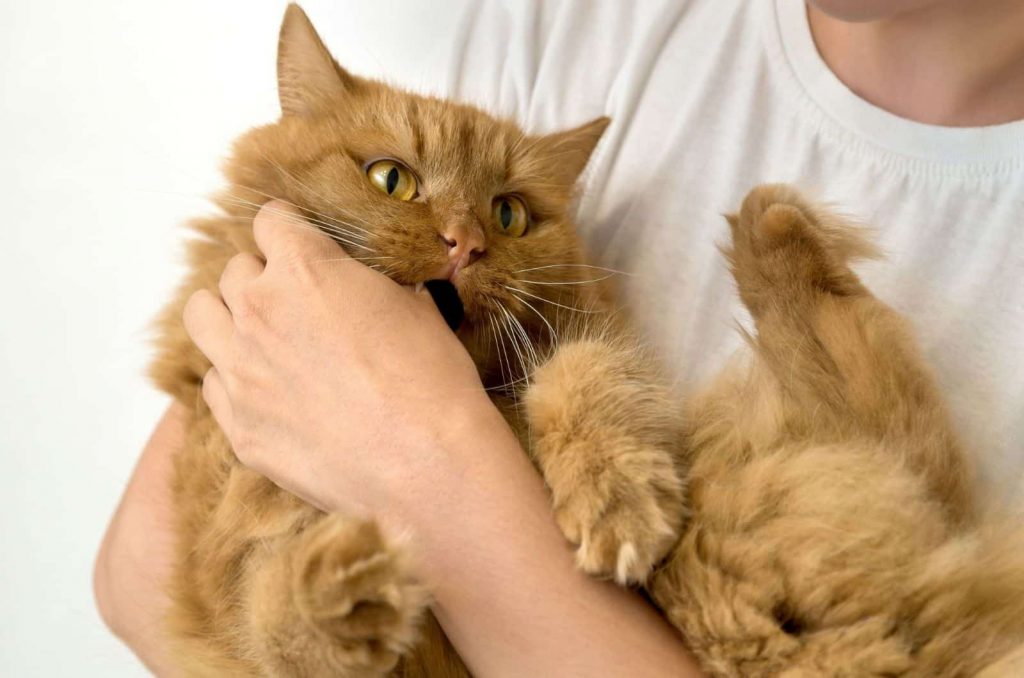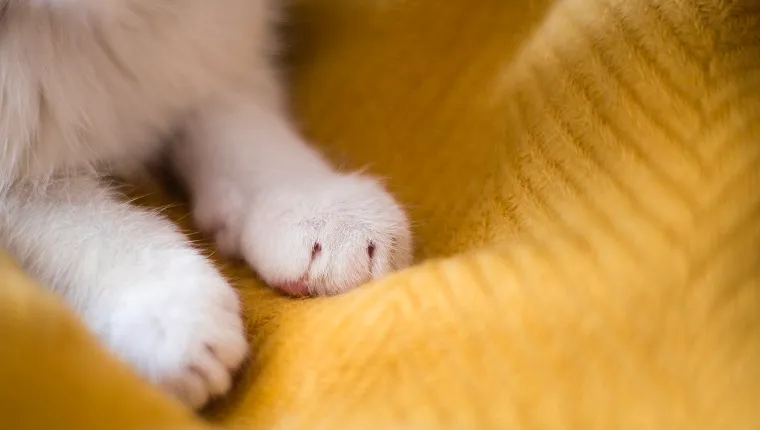Marking Territory
Cats Knead to Claim Ownership

Cats kneading is a common behavior that many cat owners have witnessed at some point. It’s a peculiar action where cats press their paws into soft surfaces, such as blankets or laps, often accompanied by rhythmic movements of their legs. While it may look like the cat is trying to make biscuits, there are several reasons why cats knead, and claiming ownership is just one of them.
One reason cats knead is due to their instinctual behavior inherited from their wild ancestors. In the wild, mother cats use kneading as a way to prepare nests for their kittens by compressing the grass or leaves underneath them to create a comfortable space for their babies. This behavior has been passed down through generations, and domesticated cats may exhibit this behavior even in the absence of any physical need to create a nest.
Cats also knead to claim ownership or mark territory, which is often misinterpreted as claiming you as their owner. However, it’s more accurate to say that they’re marking the object or surface they’re kneading on with their scent and pheromones. By doing so, cats are essentially claiming dominance over that particular space.
Another reason for cat kneading is self-soothing behavior. Some cats may engage in kneading when they feel anxious, stressed, or overwhelmed. By repeating the motion of pressing their paws into a soft surface, cats can calm themselves and relieve tension. This is often accompanied by purring, which serves as an additional calming mechanism.
Cats may also knead due to sensory stimulation and pleasure. The sensation of their paws pressing into a soft surface can be enjoyable for them, providing a form of tactile stimulation that some cats crave. Additionally, the texture of different fabrics or surfaces can stimulate their whiskers and provide a pleasurable experience.
Finally, some experts believe that cat kneading is also related to memory recall and nostalgia. As kittens, cats used to knead on their mother’s belly to stimulate milk production and comfort. In adulthood, they may continue this behavior as a way to reconnect with their past experiences and memories of their kittenhood.
Cats knead to leave their scent on surfaces, claiming ownership and marking their territory.
Cats knead to leave their scent on surfaces as a way to claim ownership and mark their territory. This behavior is rooted in their natural instinct to establish boundaries and communicate with other animals.
When cats knead, they release pheromones from glands located on their paws, which are then deposited onto the surface being manipulated. These pheromones contain information about the cat’s identity, sex, reproductive status, and individuality, allowing them to leave a chemical signature that communicates their presence.
By kneading on surfaces, cats are able to establish a sense of familiarity and comfort in their environment. This is often seen in cats who have been adopted into new homes or introduced to new surroundings, as they will frequently knead on furniture or bedding to create a scent-based connection to their new space.
Cats also use kneading as a means of self-soothing and relaxation. The rhythmic motion of kneading can be calming for cats, much like the way humans might engage in activities such as knitting or other repetitive tasks to unwind.
Another reason cats knead is due to their natural instinct to prepare a safe space for nursing or giving birth. Female cats often exhibit kneading behavior when they are pregnant or about to give birth, as this helps them to stimulate milk production and create a comfortable space for their kittens.
In addition to these reasons, cats may also knead simply because it feels good to them! Cats have scent glands on their paws that release pheromones whenever they press down on a surface. When they knead, they are able to stimulate the sensation of these scent glands and experience pleasure as a result.
It’s worth noting that some cats may knead more frequently or intensely than others due to various factors such as age, health, or individual temperament. Additionally, while kneading is often associated with territorial marking, it can also be an expression of affection or comfort-seeking behavior in cats.
Self-Soothing Behavior
Kneading as a Stress Relief Mechanism
Cats have been a source of companionship and joy for millions of people around the world. One of their most endearing behaviors is kneading, which can be quite puzzling to some but has several reasons behind it. Kneading is a unique way cats show affection, mark their territory, exercise their muscles, alleviate stress, and even prepare for sleep.
Firstly, kittens learn to knead by nursing from their mothers. The action of kneading helps stimulate milk production in the mother cat, making it a crucial aspect of a kitten’s development. As adult cats continue to exhibit this behavior, they may associate kneading with feelings of comfort, security, and nurturing. When a cat kneads on its owner, it is essentially asking for attention and affection.
Secondly, cats have scent glands located in their paws. These glands release pheromones onto surfaces as the cat kneads, allowing them to mark their territory. This behavior is especially evident when a cat kneads on its bed or blanket, marking it with their scent so they can identify it as belonging to them.
Thirdly, kneading helps cats maintain flexibility and muscle tone in their paws and legs. By constantly moving their joints through flexion and extension, cats are able to exercise these muscles and prevent stiffness from developing. This is especially beneficial for older or arthritic cats that may need assistance staying mobile.
Fourthly, kneading can be a self-soothing behavior in cats. Just like humans engage in activities such as yoga or meditation, cats knead to calm themselves down. The repetitive motion of their paws and the gentle pressure on their muscles help them relax and release tension. Cats often exhibit this behavior when they’re feeling anxious or overwhelmed.
Lastly, kneading is closely linked to a cat’s instinctual need for comfort and relaxation before sleep. In the wild, cats will often prepare a resting spot by kneading it into a soft, comfortable surface. Domesticated cats have adapted this behavior to create their own cozy sleeping spots by kneading on their owners or favorite blankets.
When your cat kneads on you, it is not just an accident – it’s a deliberate action that expresses affection and trust. By understanding the reasons behind this behavior, you can reciprocate with attention and affection, strengthening the bond between you and your feline companion.
Kneading is a selfsoothing behavior that helps cats relax and release tension after experiencing stress or anxiety.

Cats have been kneading for centuries, and it’s a behavior that’s deeply rooted in their instincts. While it may seem like a simple action, kneading serves several purposes that are essential to your cat’s emotional and physical well-being.
Here are 5 reasons why your cat kneads you:
1. Self-soothing behavior
Kneading is a self-soothing behavior that helps cats relax and release tension after experiencing stress or anxiety. When cats knead, they’re stimulating the nerves in their paws, which can be calming and comforting. It’s similar to humans taking a warm bath or listening to soothing music to unwind.
2. Marking territory
Cats have scent glands in their paw pads, and when they knead, they deposit their scent on the surface they’re kneading on. This behavior is a way for your cat to mark its territory and claim ownership. It’s especially common if your cat kneads on soft surfaces like blankets or pillows.
3. Memory recall
Kneading can be a way for cats to remember their mothers and the comfort of nursing. Kittens learn to knead by watching their mothers, who use this behavior to stimulate milk production and bond with their kittens. As your cat grows older, kneading may evoke memories of its early days with its mother.
4. Physical comfort
Kneading can help loosen up tight muscles and joints in your cat’s body, especially if they’re experiencing pain or stiffness. The action of kneading can be therapeutic for cats, helping to reduce inflammation and promote circulation.
5. Affection and bonding
Cats often knead their owners as a way to show affection and bond with them. When your cat kneads on you, it may be a sign that they feel comfortable and relaxed in your presence. It’s not uncommon for cats to knead on their favorite person or object, which can strengthen the bond between them.
Motherly Instincts
Pregnant Cats Knead to Prepare for Litter
Cats have been observed kneading with their paws for thousands of years, and it’s a behavior that has puzzled many pet owners. However, kneading is not just a random action; it serves several important purposes in a cat’s life. One of the most common reasons cats knead is to mark their territory. They do this by depositing pheromones from scent glands located on their paws onto surfaces they come into contact with.
This behavior helps cats establish a sense of security and ownership over the area, which can include your home or furniture. It’s not uncommon for pregnant cats to knead more frequently than usual, as this can help them prepare a safe space for their kittens to birth and nurse. This is where understanding why cats knead becomes especially important, especially if you’re expecting a new addition to your family.
Another reason cats knead is to self-soothe or relax. It’s possible that pregnant cats may find the motion calming and comforting as they prepare for motherhood. Cats often exhibit this behavior when they feel happy, contented, or even sleepy. This can be a way for them to release any tension or stress and recharge their batteries.
Some owners also believe that kneading is an instinctual behavior left over from the kitten days. Newborn kittens need to knead their mother’s belly to stimulate milk production and get enough food, so they continue this behavior as part of their natural instincts even after they’ve grown up.
In addition to these reasons, there may be a practical explanation for why cats knead: to prepare for or comfort themselves while using the litter box. Cats often prefer to dig and scratch at the surface before and during their bathroom breaks. This is likely due to an instinctual urge to cover their waste and hide it from potential predators.
Finally, some scientists believe that kneading could be a way for cats to exercise or maintain flexibility in their paws and limbs. By constantly stretching and moving their muscles, cats can stay supple and agile, which is essential for their survival especially during times of rapid growth like pregnancy.
Overall, it’s clear that pregnant cats knead for several reasons: to mark territory, self-soothe or relax, exhibit a natural instinctual behavior, prepare for the litter box, and exercise. While we may never know for certain why each individual cat behaves in this way, by understanding these motivations, you can better appreciate their unique personalities and behaviors.
Pregnant cats knead to prepare their bodies for the upcoming birth by stimulating blood flow and helping their uteruses contract.
Kneading is a common behavior exhibited by cats, and it’s often associated with comfort and relaxation. However, pregnant cats knead for a different reason – to prepare their bodies for the upcoming birth.
When a cat kneads, she stimulates blood flow in her body, particularly in her uterine area. This increased blood circulation helps to nourish both the developing kittens and her uterus itself. As her kittens grow and mature, they require adequate blood supply to receive nutrients and oxygen for their development. By stimulating blood flow through kneading, a pregnant cat can ensure that her kittens receive the necessary resources to grow healthy and strong.
Kneading also helps to stimulate uterine contractions in a pregnant cat. These contractions are essential for preparing the uterus for labor and delivery. As the kittens mature and prepare to exit the womb, the uterine contractions become stronger and more frequent. By kneading, a pregnant cat can initiate these contractions, helping her body to prepare for the upcoming birth.
Kneading is also an important behavior for cats in general. It helps to stimulate the release of hormones associated with comfort and relaxation, such as oxytocin. This hormone has been linked to feelings of calmness and contentment in cats. As a pregnant cat kneads, she may be releasing these hormones to promote her own feelings of relaxation and well-being during this critical period.
Additionally, kneading can help to stimulate the mammary glands in a pregnant cat. These glands produce milk for the kittens once they are born, so stimulating them through kneading can help prepare the mother’s body for lactation. By releasing hormones associated with milk production and maternal behavior, kneading can play an important role in preparing a cat for motherhood.
Finally, it’s worth noting that kneading is often a self-soothing behavior in cats. Pregnant cats may knead to calm themselves and cope with any discomfort or anxiety they may be experiencing during pregnancy. By engaging in this comforting behavior, a pregnant cat can help regulate her own emotions and prepare herself for the challenges of motherhood.
Memory Trigger
Cats Recall Memories Associated with Kneading
Cats have a unique behavior known as kneading, which is often associated with feelings of comfort and relaxation. While it’s common to see cats knead on soft surfaces such as blankets or pillows, some cats also knead on their owners’ laps or chests, indicating a strong bond between the cat and its human caregiver.
The origins of kneading in cats date back to their wild ancestors, who used this behavior to stimulate milk letdown before nursing their kittens. Even though domesticated cats no longer need to nurse their young, they retain this instinctual behavior as a way to self-soothe and mark their territory.
One reason why cats knead is to release pheromones from glands in their paws. These pheromones are chemical signals that convey information about the cat’s identity, reproductive status, and territorial markers. By kneading on different surfaces, a cat can deposit these pheromones and claim ownership of its territory.
Another reason cats knead is due to a release of oxytocin, often referred to as the “cuddle hormone.” Oxytocin promotes feelings of relaxation and bonding between mammals, including humans. When a cat kneads on their owner’s lap or chest, it may be releasing oxytocin, which strengthens the bond between the two individuals.
Cats also knead due to physical comfort. Kneading helps them stretch their muscles, especially in the paws and legs, which can become stiff from lack of exercise or age-related mobility issues. By kneading on a soft surface, a cat can loosen up its joints and relieve any discomfort or tension.
Finally, cats may knead due to emotional comfort. Kneading is often associated with feelings of security and familiarity. A cat that kneads on its owner’s lap may be seeking reassurance and comfort from the presence of their human companion. This behavior can also signal affection and attachment between the cat and its caregiver.
Cats may knead in response to memories associated with nursing or being comforted, which can evoke feelings of security and relaxation.

Cats may knead in response to memories associated with nursing or being comforted, which can evoke feelings of security and relaxation.
The act of kneading is often associated with a cat’s early life experience of nursing from their mother. Mother cats will often groom and care for their kittens by providing them with milk and warmth.
As kittens grow and become weaned, they continue to associate the sensation of being on their mother’s warm belly as a source of comfort and security. This association can be so strong that even in adulthood, cats may engage in kneading behavior when they feel content or relaxed.
Another reason why cats knead is due to sensory stimulation. Cats have scent glands in their paws, which they use for marking their territory by leaving pheromones behind. When a cat kneads on you, it’s not only a sign of affection but also an attempt to leave its scent mark on the surface.
Cats may also knead when they are feeling anxious or stressed, as a way of self-soothing and calming themselves down. This behavior can be especially common in multi-cat households where competition for resources and attention is high.
Additionally, cats may knead due to boredom or lack of stimulation. If your cat has too much energy and not enough outlets, they might resort to kneading as a way to release pent-up energy and engage their mind-body connection.
The reasons behind why cats knead can be complex and multi-faceted. However, by understanding the underlying causes, you can better appreciate this unique behavior in your feline companion and foster a deeper bond with them through shared experiences and affectionate moments.
Sensory Stimulation
Kneading to Stimulate Senses
The act of kneading in cats is a common behavior that serves multiple purposes, and it’s not just about being affectionate. While some people believe that kneading is a leftover from their wild ancestors who used to knead earth to make nests, the reasons behind this behavior are more complex.
Here are 5 reasons why your cat may be kneading you:
1. Marking and Claiming Territory
Cats have scent glands in their paws, and when they knead on a surface, they deposit their scent behind. This behavior is often seen as a way of claiming ownership or marking territory. When your cat kneads on you, it’s possible that they’re leaving their scent behind and claiming you as their own.
2. Self-Soothing and Relaxation
Kneading can be a calming behavior for cats, helping them relax and release tension. It’s often seen in kittens when they’re nursing, as it helps them stimulate milk production from their mother. As adult cats, kneading may serve the same purpose – to self-soothe and calm themselves down.
3. Memory Recall and Nostalgia
Cats have a strong sense of smell and memory, which can be linked to their kneading behavior. When they encounter a familiar scent or surface, it may trigger memories from their past, such as their mother’s nursing. This can cause them to exhibit kneading behavior again, even if it’s been years since they last nursed.
4. Communication and Affection
Kneading is often seen as a sign of affection in cats, and when they knead on you, it may be their way of saying “I love you” or “I feel comfortable around you”. It’s also a form of communication – they’re expressing their emotions and needs to you.
5. Physical Relief and Exercise
Kneading can help cats stretch and exercise their muscles, particularly in their paws and legs. It may also be a way for them to relieve physical tension or discomfort, such as arthritis or joint pain.
In conclusion, kneading is a complex behavior that serves multiple purposes in cats. By understanding the reasons behind this behavior, you can better appreciate your cat’s emotional and physical needs and strengthen your bond with them.
Cats knead to stimulate their whiskers, paws, and other senses, providing a tactile experience that helps them feel grounded and connected.
Cats knead to stimulate their whiskers, paws, and other senses, providing a tactile experience that helps them feel grounded and connected. This behavior is often seen as a sign of contentment and relaxation, but it also serves several important purposes.
One reason cats knead is to mark their territory with scent. They have scent glands in their paws, which they deposit onto surfaces when they knead. This allows them to claim ownership of a particular space or object and also helps them to identify their surroundings through smell.
Cats knead to stimulate their brain’s reward system, releasing feel-good hormones such as dopamine and serotonin. This can create a sense of calmness and satisfaction in the cat, making it more likely for them to repeat the behavior. Kneading has been linked to increased levels of oxytocin, also known as the “love hormone,” which strengthens bonding between the cat and their owner.
The act of kneading itself is also a natural reflex for cats, dating back to when they were kittens. In the womb, cats would use their paws to move in preparation for birth, so this behavior remains instinctual even as adults. The muscle memory associated with kneading allows cats to continue this motion without conscious thought.
Cats knead to self-soothe and release tension, particularly during times of stress or anxiety. This can manifest as over-grooming, pacing, or increased vocalization, but kneading is a more subtle sign that your cat may be feeling overwhelmed. Engaging in this behavior allows them to channel their energy into something calming.
Finally, cats knead to engage with their environment through texture and sensation. This can include kneading on soft surfaces like blankets or pillows, as well as more rigid objects like concrete or wood. By varying the pressure and motion used for kneading, cats are able to experience a range of tactile sensations that help them explore and understand their surroundings.
- Best Lusha Alternatives for 2025 - April 19, 2025
- Best Overloop Alternatives for 2025 - April 19, 2025
- Best Snov.io Alternatives for 2025 - April 18, 2025



